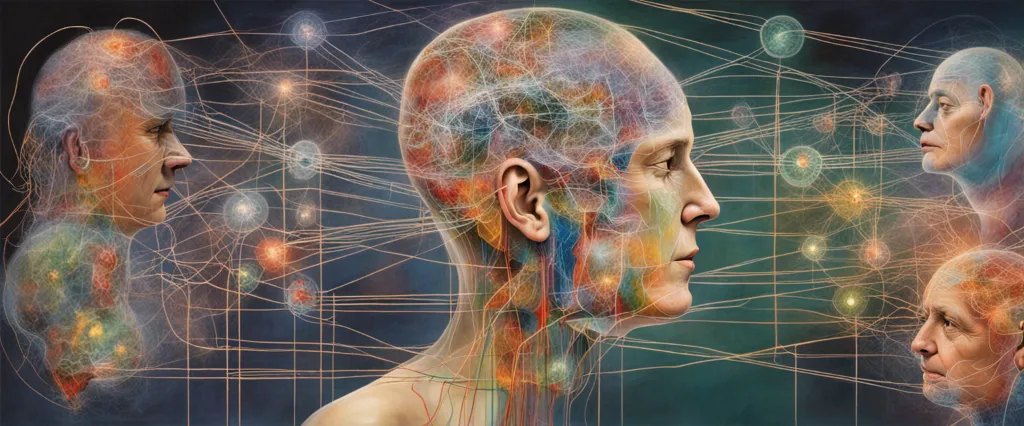
In the vast landscape of psychological investigations, understanding the intricate workings of the mind remains a paramount endeavor. Human behavior, emotions, and social interactions have long captivated scholars and readers alike, prompting the production of countless literature exploring these subjects. Among the myriad of books attempting to unravel the complexities of the human psyche, two prominent works stand out: “Social” by Matthew D. Lieberman and “Emotional Intelligence” by Daniel Goleman. Both of these groundbreaking books delve into the depths of human nature, shedding light on the critical importance of social connections and emotional awareness in our lives.
As social beings, humans possess an innate need for social interactions. From the earliest stages of human development, we seek affiliation, cooperation, and bonds with others. Social by Matthew D. Lieberman, a premier neuroscientist and social psychologist, presents a compelling argument for the centrality of social connections in shaping our individual and collective identities. In this book, Lieberman skillfully weaves together scientific research, personal anecdotes, and evolutionary perspectives to elucidate the vital role that social connections play in our overall well-being.
On the other hand, Daniel Goleman’s “Emotional Intelligence” delves into the intricate realm of emotions, exploring how they shape our thoughts, actions, and relationships. As a distinguished psychologist, Goleman brings to the forefront the notion that emotional intelligence, defined as the ability to recognize, understand, and manage our own emotions, as well as empathize with others’, plays a fundamental role in our personal and professional lives. Drawing from extensive research in psychology, neuroscience, and sociology, Goleman presents a comprehensive study on the importance of emotional intelligence, offering practical strategies to cultivate and harness this essential skill.
While both “Social” and “Emotional Intelligence” delve into the intricacies of human behavior, they approach their subjects from different perspectives. Lieberman focuses predominantly on the social aspects of human nature, examining how our brains are wired for social connection and the extent to which social interactions shape our emotions, decisions, and well-being. Goleman, on the other hand, places a stronger emphasis on emotional intelligence, illuminating the profound impact that emotional awareness and regulation have on personal happiness, work success, and meaningful relationships.
As we embark on a comparative study of these two seminal works, we aim to uncover the nuances, convergences, and divergences of their theories and findings. By examining the scientific foundations, practical applications, and overarching implications of Lieberman’s “Social” and Goleman’s “Emotional Intelligence,” we endeavor to deepen our understanding of the human mind while highlighting the critical significance of social connections and emotional intelligence in our modern society.
Through this comparative study, we hope to shed light on the multifaceted nature of human experience, bridging the gap between the cognitive and emotional dimensions of our lives. By exploring the interplay between social interactions and emotional intelligence, we may uncover novel insights into our own behaviors, relationships, and personal growth. As we embark on this intellectual journey, let us delve deep into the realm of human psychology, guided by the wisdom and research embedded within the pages of “Social” and “Emotional Intelligence.”
Brief Summary of Two Books
Social by Matthew D. Lieberman
Social: Why Our Brains Are Wired to Connect” by Matthew D. Lieberman is a book that explores human social behavior from a neuroscience perspective. Lieberman, a renowned social psychologist and neuroscientist, demonstrates how our brains are evolutionarily wired for social connections and interactions with others. Throughout the book, he presents scientific evidence and research studies to support his argument.
Lieberman delves into various aspects of social behavior, including empathy, cooperation, and the impact of social isolation on our well-being. He explains how our brain’s structure and neural networks are specifically designed to facilitate social interactions, allowing us to understand the thoughts, emotions, and intentions of others. He also explores how our brain’s social abilities have influenced our evolution as a species and have played a crucial role in our survival and success.
Furthermore, Lieberman examines the negative consequences of social isolation and its implications for mental and physical health. He highlights the detrimental effects of loneliness on our overall well-being, stating that it can increase the risk of various health problems, including depression, anxiety, and cardiovascular diseases.
In “Social,” Lieberman emphasizes the crucial importance of social connections in our lives and how they contribute to our happiness and overall sense of well-being. He suggests practical strategies to enhance our social connections and promote healthier relationships, ultimately leading to a happier and more fulfilling life.
Overall, Lieberman provides a compelling argument backed by scientific research to explain why social connections are fundamental to our nature, shedding light on the significance of human social behavior and its impact on our overall health and happiness.
Emotional Intelligence by Daniel Goleman
Emotional Intelligence” by Daniel Goleman is a groundbreaking book that explores the concept of emotional intelligence and its impact on various aspects of life. Goleman argues that emotional intelligence, which encompasses self-awareness, self-regulation, empathy, and social skills, is equally, if not more, important than intellectual intelligence in achieving success and happiness.
The book starts by introducing the concept of emotional intelligence and presenting scientific evidence that supports its significance. Goleman explains how emotions profoundly affect our behavior, decision-making, and relationships, and how emotional intelligence can be cultivated and enhanced.
Goleman explores key components of emotional intelligence, such as self-awareness, which involves recognizing and understanding one’s own emotions, and self-regulation, the ability to manage and control one’s emotions effectively. He offers practical guidance and exercises to develop these skills, as well as strategies to handle stress and difficult situations.
Furthermore, the book delves into empathy, the ability to understand and relate to the emotions of others, and the crucial role it plays in building relationships and effective communication. Goleman emphasizes the importance of empathetic listening and provides examples of how empathetic leaders and individuals can create positive social connections.
The book also explores the application of emotional intelligence in various areas of life, including personal relationships, workplaces, education, and parenting. Goleman highlights the impact of emotional intelligence on leadership and illustrates how emotionally intelligent leaders can inspire and motivate others, fostering a positive and productive environment.
Throughout “Emotional Intelligence,” Goleman provides numerous case studies, real-life examples, and scientific research to support his arguments. The book offers valuable insights and practical advice for individuals seeking to improve their emotional intelligence, enhance their relationships, and achieve success in all areas of life.
Comparison between Two Books

Similarities in Communication
Both “Social” by Matthew D. Lieberman and “Emotional Intelligence” by Daniel Goleman touch upon the topic of communication, highlighting some similarities:
1. Importance of Nonverbal Communication: Both books emphasize the significance of nonverbal cues in effective communication. Lieberman discusses the crucial role of the social brain system, which helps us interpret nonverbal signals like facial expressions, body language, and tone of voice. Similarly, Goleman emphasizes that nonverbal communication, including facial expressions and gestures, can greatly impact how a message is perceived and understood by others.
2. Relationship Building: Both books recognize that communication is key to nurturing relationships and establishing connections. Lieberman explores the concept of “social pain” and how important social bonds are in human life. Effective communication is highlighted as a means to build and maintain these connections. Goleman also underscores the role of communication in fostering rapport, trust, and emotional connections with others.
3. Empathy and Understanding: Both authors stress the importance of empathy and understanding in communication. Lieberman emphasizes the role of empathy in effective communication, as it helps us understand others’ perspectives and respond in ways that align with their emotions. Goleman discusses the aspect of empathy in emotional intelligence, highlighting its significance in understanding others’ feelings and experiences.
4. Emotional Expression: Both books acknowledge the role emotions play in communication. Lieberman delves into how our brains are wired for emotional expression and social connection, and how emotions can be conveyed through verbal and nonverbal cues. Goleman emphasizes that emotional intelligence includes the ability to effectively express and manage emotions, which in turn impacts communication and relationships.
5. Mindfulness in Communication: Both authors touch upon the importance of mindfulness in effective communication. Lieberman explains how being present and paying attention to the social signals of others can enhance communication. Goleman discusses how being mindful of our own emotions and reactions can help us respond more effectively in communication, making it more empathetic and constructive.
Overall, the books “Social” by Matthew D. Lieberman and “Emotional Intelligence” by Daniel Goleman share similarities in highlighting the role of nonverbal communication, relationship building, empathy, emotional expression, and mindfulness in effective communication.
Divergences in Communication
Social by Matthew D. Lieberman and Emotional Intelligence by Daniel Goleman are both insightful books that delve into the intricacies of human connections. While they share a common focus on understanding and navigating social dynamics, they differ in their approaches and perspectives. When it comes to the divergence in their discussions on communication, several key points emerge.
In Social, Lieberman presents a comprehensive exploration of the human brain’s social nature and how it influences our interactions. While communication is a fundamental aspect of social behavior, Lieberman goes beyond the surface level of verbal and nonverbal communication. He delves into the neural processes that underlie social interactions and examines the importance of understanding others’ mental states for effective communication. Lieberman emphasizes the role of the brain’s unique social circuits and their impact on our ability to connect with others.
On the other hand, Emotional Intelligence by Goleman focuses more on the emotional aspects of communication and their role in building strong relationships. Goleman defines emotional intelligence as the ability to recognize, understand, and manage our own emotions while being mindful of others. Communication, for Goleman, is closely linked to emotional intelligence, as he discusses how emotions shape our interactions and influence the effectiveness of our communication. Goleman emphasizes the importance of empathy, active listening, and expressing emotions appropriately for successful communication.
One notable divergence in their perspectives on communication lies in their emphasis on different aspects of the social experience. Lieberman delves into the neuroscientific underpinnings of communication, highlighting the brain’s role in processing social information. He brings attention to the subconscious processes that shape our perceptions and responses within social interactions. On the other hand, Goleman focuses more on the emotional components of communication, emphasizing the awareness and management of emotions for effective connection.
Another divergence is the scope of their discussions on communication. Lieberman’s exploration of communication extends beyond interpersonal interactions to encompass broader social phenomena. He discusses the impact of social networks, cultural influences, and even social media on our communication patterns. In contrast, Goleman focuses primarily on the individual’s emotional intelligence and its influence on one-on-one communication.
While Lieberman and Goleman tackle communication from distinct angles, their insights complement each other. Lieberman’s emphasis on the neural processes deepens our understanding of the biological basis of communication, while Goleman’s focus on emotional intelligence provides practical strategies for improving interpersonal dynamics.
In summary, the divergence between Social and Emotional Intelligence regarding communication lies in their focus and perspective. Lieberman explores communication within the context of the brain’s social nature, while Goleman highlights the role of emotional intelligence in shaping effective interpersonal interactions. Together, these books provide a comprehensive understanding of communication that encompasses both neuroscientific and emotional aspects.

Conclusion
Both Social by Matthew D. Lieberman and Emotional Intelligence by Daniel Goleman are highly regarded books in the field of psychology and have their own unique merits. The choice of which book is more worthy of reading depends on the specific interests and goals of the reader.
Social by Matthew D. Lieberman explores the science behind our social nature and the importance of social connection in human life. It delves into topics such as why we feel pain when we are socially excluded, how our brains are wired for social interactions, and how our social connections impact our physical and mental well-being. This book is highly recommended for those interested in understanding the complexities of human social behavior and its impact on our lives.
On the other hand, Emotional Intelligence by Daniel Goleman focuses on the concept of emotional intelligence and the role it plays in our personal and professional success. Goleman explores how emotional intelligence can be developed and applied in various areas of life, including relationships, leadership, and decision-making. This book is particularly valuable for individuals looking to improve their emotional self-awareness, empathy, and relationship management skills.
Ultimately, choosing between the two books depends on whether you are more interested in understanding the social nature of humans and its implications (Social) or developing emotional intelligence skills (Emotional Intelligence). Both books offer valuable insights and knowledge, but the choice should be based on your specific interests and goals.



